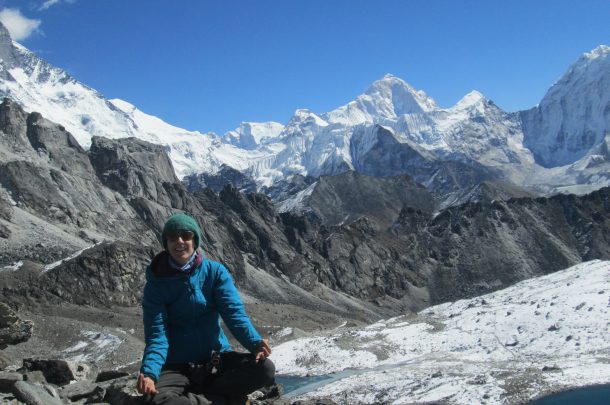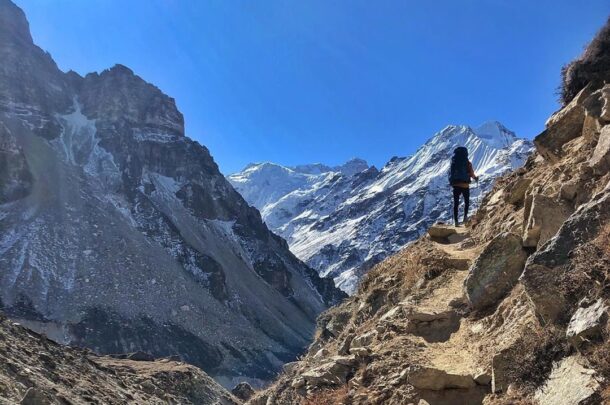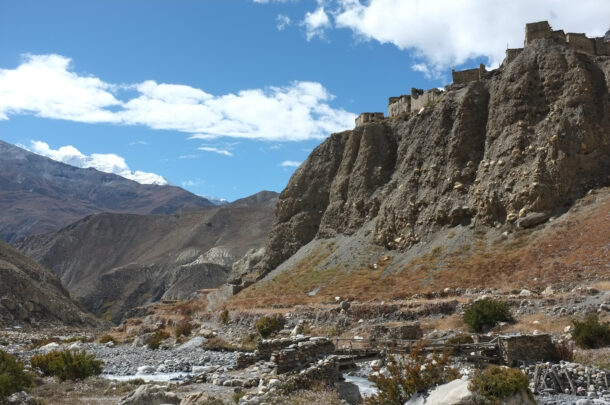Annapurna Circuit with Tilicho Lake trek takes you around the amazing Annapurna Massive from west to east. This incredible trekking in Nepal has long been a favourite amongst nature lovers and mountaineers, as you can witness breathtaking views of around 140 peaks and mountains across the Annapurna Himalayas.
This scenic trek in Nepal’s Annapurna Himalayas also takes you to Tilicho Lake (4,949m / 16,237ft), one of the highest lakes in the world! That’s not all—you’ll also cross Thorong La Pass (5,416m / 17,764ft), the highest mountain pass in Nepal, and explore iconic destinations like Manang, Muktinath Temple, Pokhara, and more along the way.
Along the way, you’ll journey through the Annapurna Conservation Area, home to a rich variety of flora and fauna, including the rare red panda and the elusive snow leopard.
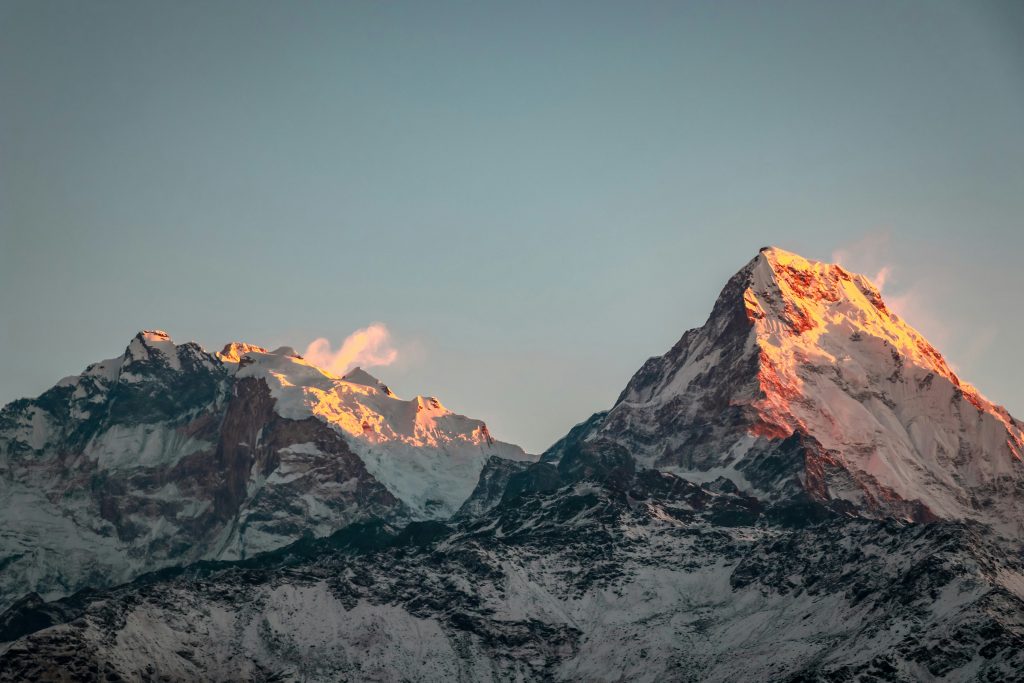
Annapurna Circuit Trek is famous for its panoramic view of the world’s best mountain peak in the Himalayas. On this trek, you will witness breathtaking views From Annapurna I (8,091 meters) to Dhaulagiri (8,167 meters), Manaslu (8,163 meters), and Gangapurna (7,455 meters). Also, the sunrise and sunset from a spot like Pisang or Manang is absolutely magical.
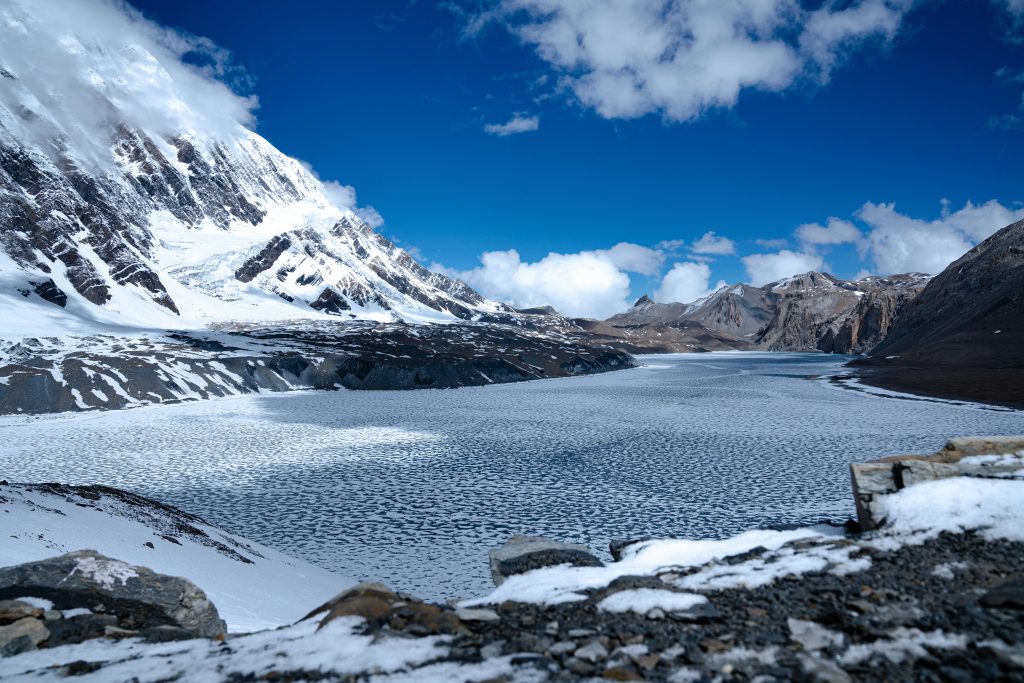
Tilicho Lake is also known as Annapurna Lake, which is the world’s highest lake, situated at an altitude of 4,919 meters. This lake is a sacred site for the Hindus as it is believed that it is connected to Mt Kailash. From the main Annapurna Circuit trail, Tilicho Lake is approximately 6 kilometers. An ice cliff surrounds this peaceful lake and the beauty of this lake is indescribable.
Situated at an altitude of 5,416 meters, Thorong La Pass is the most challenging part of the Annapurna circuit with the Tilicho Lake trek. From this high-altitude mountain pass, you can witness some incredible views of the Annapurna and Dhaulagiri ranges.
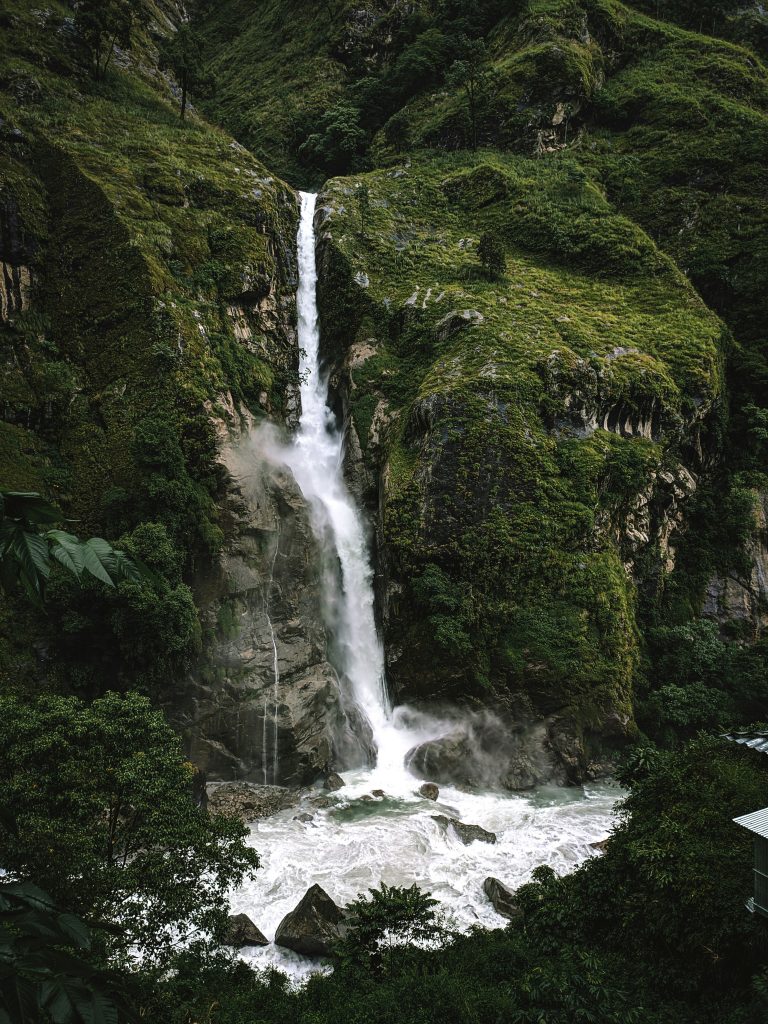
Another main reason trekkers loved the Annapurna circuit so much is due to the Diverse landscape it presents at every turn. Around the Annapurna region, you will travel from lush subtropical forests and terraced paddy fields to alpine meadows and arid high-altitude deserts. Passing through the lush hills, beautiful village, waterfalls and beautiful rhododendron forest adds the beauty of this trek.
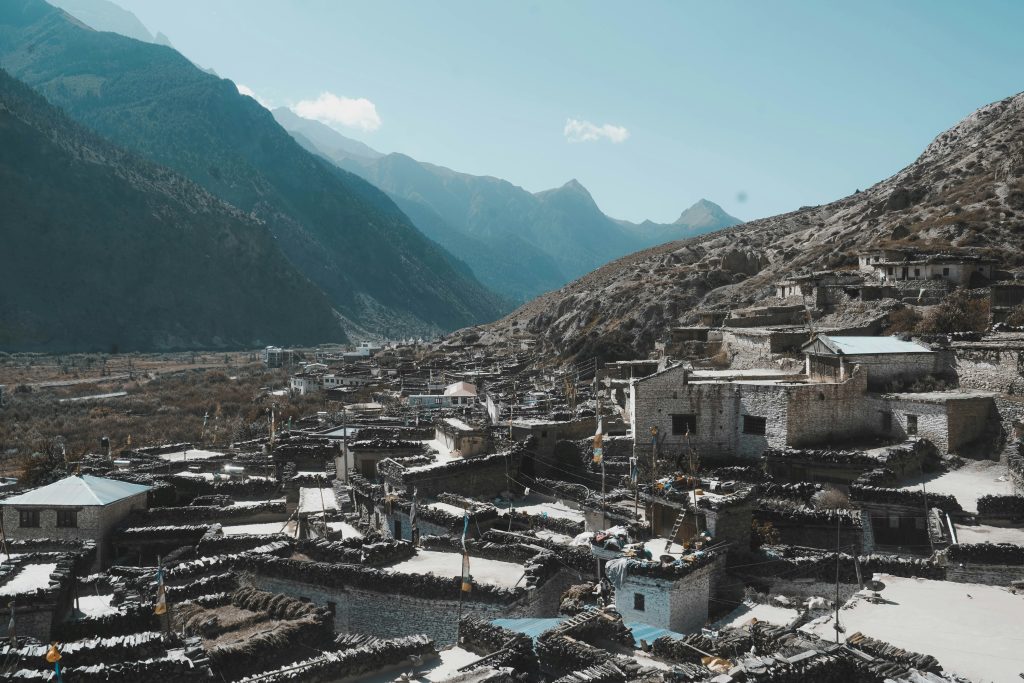
On this Annapurna Circuit with Tilicho lake trek, you will travel from Gurung Communities to the Tibetan-influenced communities of Manang and Marpha. It allows you to immerse in the firsthand taste of Nepal’s multi-ethnic heritage. It’s fun to experience their unique traditions, delicious food, colorful festivals, and traditional clothing.
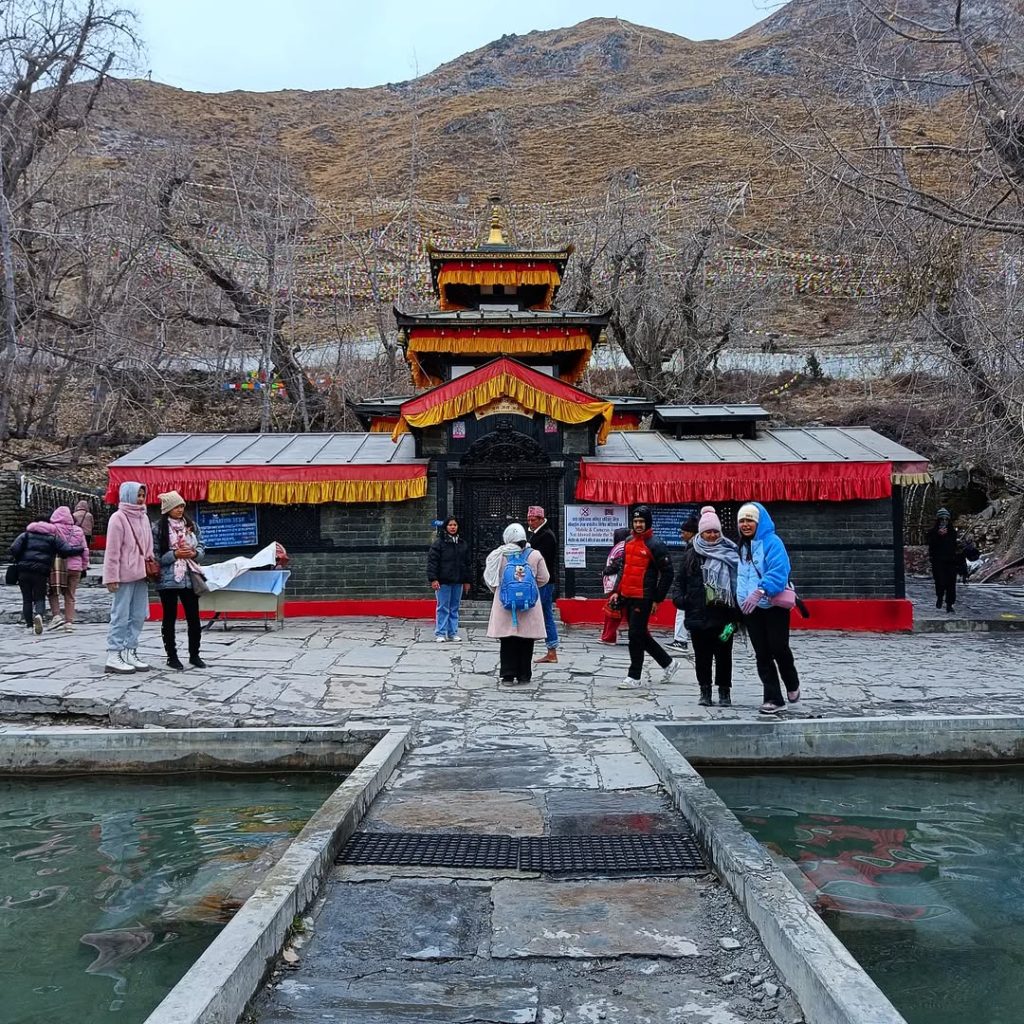
Another major attraction of the Annapurna circuit with the Tilicho Lake trek is visiting Muktinath Temple. Muktinath temple is the world’s highest altitude temple, which stands at an altitude of 3,710 meters. This temple holds sacred significance to the Hindu and Buddhist people. Pilgrims bathe under the 108 sacred water spouts, believing the ritual washes away their sins and purifies the soul. The temple is also home to an eternal flame that burns naturally from the earth, adding to its mystic atmosphere.
This Annapurna Circuit with Tilicho Lake trek takes you through the Kali Gandaki Gorge. This world’s deepest gorge is situated between the Annapurna and Dhaulagiri ranges. Watching this gorge, you will understand how powerful nature is. Also the dramatic cliff and crossing the thrilling suspension bridge is equally adventurous.
The Annapurna Circuit with Tilicho Lake trek consists of a ready-made package with a carefully made itinerary of 16 days. You will start your journey from Kathmandu by driving to Besisahar on the bus. Then, further driving, you will reach Chame, which is the starting trekking point of this Annapurna Circuit with Tilicho Lake Trek.
While the actual trek has 10 days of trekking, including one rest day at Manang for acclimatization. Following the standard Annapurna Circuit trekking route you will heads to the famous world’s highest lake, Tilicho Lake.
After visiting Tilicho Lake, a mostly downhill trek goes back to Siri Kharka, from where it will continue back on the Annapurna Circuit by heading to Yak Kharka. During this trek, no camping is required, and High Route Adventure will provide you with the best available guest house or teahouses during the trek.
Famous mountains to look out for while trekking are the Annapurna mountains I to IV, reaching up to 8,091m/26,545ft, Mt Dhaulagiri 8,167m/26,795ft, Mt Manaslu 8,163m/26,781ft, Mt Gangapurna 7,455m/24,459ft, Pisang Peak 6,091m/19,984ft and Tilicho Peak 7,134m/23,406ft.
Your average trekking hours per day are between 5 and 6 hours, going downhill and uphill with a few steep parts. The trails are well-maintained and mostly comfortable to trek, with good guesthouse accommodations along the way.
Widely considered one of the best treks in Nepal, the Annapurna Circuit with Tilicho Lake Trek is best enjoyed during the spring or autumn seasons, when the weather is most favorable and the mountain views are at their clearest.
This trek offers a rich blend of culture, stunning high-altitude mountains over 8,000m (26,247ft), authentic Himalayan villages, a visit to Tilicho Lake—the highest lake in the world at 4,949m (16,237ft)—and the unforgettable experience of crossing Nepal’s highest mountain pass, Thorong-La at 5,416m (17,764ft).
Duration: Those who want to participate in this Annapurna Circuit With Tilicho Lake Trek must have 16 Days of vacation.
Previous trekking experience: This trek is not for first-time trekkers. It’s best to have to have some trekking experience.
Physical Fitness: Crossing the Throng La Mountain Pass is tough, so all the trekkers must be in good physical condition.
Health Condition: Trekkers must be in good overall health, with no serious medical conditions.
Age requirements: No age restrictions but recommended for 18-70 yrs.
Daily walking hours: Trekkers should be able to walk for 5-7 hours during a trek.
The best time for the Annapurna circuit with Tilicho Lake is during the Spring (March-May) and Autumn (September-November) because most of the time in this season, you can expect perfect weather conditions. Also, with a clear view of the sky, moderate trekking temperature and good visibility, you can enjoy the perfect view of breathtaking landscapes and mountain peaks.
Let’s see about each season so that it will help you to understand more in detail so you can choose which season suits you.
Why Spring is Ideal:
Spring, which is the peak season for trekking in Nepal, is best for Annapurna Circuit With Tilicho Lake Trek, and here is why:
Challenges:
Due to the starting trekking season you can expect huge crowds in Annapurna trails and tea houses. To avoid getting problems with room and other things, make sure to book the trek in advance.
Why Some Avoid Monsoon Trekking:
Monsoon season in Nepal experienced heavy rainfall, and the trail path became muddy and slippery, mostly in the lower areas. Also, landslides and floods are common concerns. Due to the formation of black clouds and rainfall, the visibility is reduced.
Why You Might Consider It Anyway:
Special Note About Tilicho Lake in Summer: Reaching Tilicho Lake during monsoon is highly discouraged due to the increased risk of landslides and unpredictable weather patterns.
Why Autumn Reigns Supreme:
Autumn is considered the best time of year and the most loved season for trekking the Annapurna circuit with Tilicho Lake Trek. Here is the reason why:
Why Winter Challenges Even the Most Experienced Trekkers:
Trekking Annapurna Circuit with Tilicho Lake is possible, but the challenge and preparation require a full plan and preparation. Here is why:
Why You Might Consider It:
Beginner trekkers should not do this Annapurna circuit via Tilicho Lake in winter. Only expert trekkers with proper preparation can undertake this trek.
| Season | Average Daytime Temperature (°C) | Average Nighttime Temperature (°C) | General Weather Conditions |
|---|---|---|---|
| Spring (March – May) | 10-20°C | -5 to 5°C | Clear and pleasant with blooming rhododendrons. Occasional afternoon winds. |
| Summer (June – August) | 15-25°C | 5-10°C | Monsoon season with frequent rain and cloudy days. Trails may be muddy and slippery. |
| Autumn (September – November) | 10-18°C | -5 to 5°C | Stable weather with clear skies and minimal rain. Excellent visibility for mountain views. |
| Winter (December – February) | 0-10°C | -17 to -5°C | Cold and dry with frequent snowfall at higher altitudes. Clear skies ensure great visibility. |
For Annapurna Circuit with Tilicho Lake trekking, it’s important to know that trekking permits are mandatory. These permits help support conservation efforts inside the Annapurna Conservation Area and ensure the safety and regulation of trekkers in the Annapurna region.
These are the permits that you need to carry:
| Permit Type | Cost for Foreigners | Cost for SAARC Nationals | Details |
| Annapurna Conservation Area Permit (ACAP) | USD $30 (approx. NPR 3000) | USD $5 (approx. NPR 500) | Required for entry into the Annapurna Conservation Area. |
| Trekkers’ Information Management System (TIMS) Card | USD $20 (approx. NPR 2000) | USD $7.50 (approx. NPR 1000) | Mandatory for tracking trekkers’ movements and ensuring safety. |
Note: High Route Adventure will arrange all the permits for all our trekkers before you head for the trek.
If you are looking for a short and easy trek in the Annapurna region, then we suggest you check out Short Annapurna Base Camp Trek, Gokyo Valley Trek, Mardi Himal Trek, Khopra Ridge Trek, Ghorepani Poon Hill Trek
Traveler’s note: The airport is just a few minutes away from Thamel, the main touristic area of Kathmandu, where most of the hotels, souvenir shops, and restaurants are located. Try out the Nepalese MoMo, a traditional dumpling and a staple of Nepalese Cuisine!
• Hotel Breakfast and check out
• Drive with a local bus to Beshisahar
• Check-in at the teahouse
• Explore around the market in Beshisahar
• Dinner and overnight stay at the teahouse
Traveler’s note: Did you know that the way to Beshisahar is mostly along the Trishuli River, up to Dhumbre. From there the road heads into the amazing Marshyangdi Valley!
• Teahouse breakfast and check out
• Drive via 4x4 to Chame
• Pass by Jagat
• Pass by Chyamche (Chamje), Tal, and Dharapani
• View of Annapurna II 7,937m/26,040ft on your left and on your right a part of the Manaslu Range
• Check-in at the teahouse at Chame
• Dinner and overnight stay at the teahouse
Traveler’s note: Did you know that from the Kundi you can see some of the first views of the Manaslu Mountain Range, just south of Mt Manaslu you can see the Ngadi Himal 7,871m/25,824ft and the Himalchuli 7,893m/25,896ft. A bit to the left you get to see the Lamjung Himal 6,983m/22,910ft! Near Chyamche (Chamje) we get to see one of the longest waterfalls stretching about 202m/663ft! Just before reaching Chame we can see a part of the Manaslu mountain range on your right side, and on your left the first views of the Annapurna II 7,937m/26,040ft and Annapurna massif range.
• Breakfast and departure
• Start the trek by heading up to Bhratang
• Pass by Dhikur Pokhari
• Stop by Lower Pisang
• Continue by crossing the Marsyangdi Khola River
• Ascend from here to Upper Pisang
• Dinner and overnight stay at the teahouse
Traveler’s note: Did you know that there are two routes leading to Manang, our next day’s destination. The Upper and Lower Pisang route. We follow the Upper Pisang route as it promises the best views of Mt Annapurna and the Pisang Peak!
• Breakfast and departure
• Head for the Upper Pisang trail
• Pass by Ghyaru
• Reach at Nyawal
• Continue on to Braga
• Visit Braga and Braga Monastery
• Trek a bit further uphill to Manang
• Dinner and overnight stay at the teahouse
Traveler’s note: Did you know that that Braga has the biggest monastery in the whole Manang district? As you enter the Manang region you’ll quickly notice a dryer and colder climate!
• Breakfast
• Acclimatization hike
Option 1: hike to Bhojo Gumba
Option 2: hike to Gangapurna Lake
• Dinner and overnight stay at the teahouse
• Breakfast and departure
• Trek via the western gate down the river
• Cross the river and continue along its southern bank
• Pass by Kangsar Village
• Continue uphill to Siri Kharka
• Dinner and overnight stay at the teahouse
Traveler’s note: Did you know that while trekking to Siri Kharka you get to see views of the Gungang Himal and Mt Chulu!
• Breakfast and departure
• Head for Tilicho Base Camp
• Follow the narrow trails leading gradually up to Base Camp
• Dinner and overnight stay at the teahouse
Traveler’s note: Did you know that before reaching Tilicho Base Camp we pass by a landslide area, trek with caution and always listen to safety advice from your High Route Adventure trekking guide!
• Breakfast and departure
• A steep climb starts the day off
• Follow the side of the mountain until reaching an incline
• Visit Tilicho Lake
• Retrace back all the way down, back to Siri Kharka
• Dinner and overnight stay at the teahouse
Traveler’s note: Did you know that Tilicho Lake is the highest lake in the world and that there are no known aquatic lifeforms in the lake! Particularly special to Hindu’s is that Tilicho Lake is mentioned in the Ramayan Saga of the Hindu’s Sanskrit Holy text book
• Breakfast and departure
• Retrace back downhill to Khangsar
• Continue on to the Thorang Khola Valley
• Ascend further to Yak Kharka
• Dinner and overnight stay at the teahouse
Traveler’s note: did you know that Khangsar is only populated during festival times when yak herders gather for the festivities! Today’s views are incredible and you’ll quickly notice yak herds grazing in the valley.
• Breakfast and departure
• Trek uphill towards Thorang Phedi
• Pass Ledar village and ascend furthermore
• Traverse through towering cliffs to reach Thorang Phedi
• Explore around Thorang Phedi
• Dinner and overnight stay at the teahouse
Traveler’s note: Today you can enjoy the views of Mt. Gundang, Mt. Syagang, Thorung Peak, and Mt. Khatungkan among others!
• Breakfast and departure
• Head up to the Thorang La pass, one of the highest passes in the world
• Cross the mountain pass from east to west (Manang to Muktinath)
• The trail becomes more barren and the landscape becomes more of a Wild West
• Continue on the downhill to Muktinath
• Arrival in Muktinath
• Dinner and overnight stay at the teahouse
Traveler’s note: Did you know that the Thorang-La Pass is one of the highest mountain passes in the world! Muktinath famous for its Temple with 108 water sprouts is said to have a healing and cleansing effect to all who take a dip in its holy water. This pilgrimage site is visited a whole year long by both Hindus and Buddhists.
• Breakfast and departure
• Visit the Muktinath temple with its 108 water sprouts
• Start to trek by descending downwards
• Head to the Kali Gandaki River to reach Kagbeni
• Follow the Kali Gandaki river southwards to reach Jomsom
• Dinner and overnight stay at the teahouse
Traveler’s note: Did you know that Kagbeni and Jomsom are famous for their apple orchards, depending on the season you’ll get to see these apple trees in full bloom!
• Breakfast and check out
• A morning flight takes us to Pokhara
• Hotel transfer
• Enjoy the amazing sights and activities in Pokhara
• Overnight stay at the hotel
Traveler’s note: While in this package there are no activities in Pokhara included, High Route Adventure is more than happy to arrange some for you, such as bungee jumping, paragliding, ultra-light flying, boating on Phewa Lake or a city sightseeing tour! Just request us during your booking.
• Breakfast and check out
• Transfer to the tourist bus park
• Drive via tourist bus back to Kathmandu
• Hotel check-in
• Review of your trip
• A complimentary farewell and thank you dinner is planned with a culture show
• Overnight stay at your hotel
Traveler’s note: It is also possible to fly back to Kathmandu, this will give you more time to spend back in Kathmandu as the flight just takes 25min, compared to the 6-hour bus ride.
The most common challenge that trekkers need to face during the Annapurna circuit with Tilicho Lake is high altitude. To reach Tilicho Lake and Thorong La Pass, trekkers need to walk above 4,000m, and while walking at such altitude, the chances of having altitude sickness are real.
Symptoms of altitude sickness may include nausea, headache, dizziness, and fatigue. This can happen to anyone when walking above 35,00 m, where the oxygen level is low.
To mitigate the effects of altitude:
Difficulty rating for altitude:
On this Annapurna Circuit with Tilicho Lake Trek, you will do 10 days of trekking, and on these 10 days, you need to walk for an average of 6-7 hours daily. Walking steep uphill and downhill, you need to maintain good physical stamina and strong legs, including cardiovascular fitness.
Physical preparation tips:
Difficulty rating for fitness:
The Annapurna region has varied weather conditions depending on the season. Although spring (March to May) and autumn (September to November) are considered good times, sometimes the weather can be unpredictable.
Common weather challenges:
Difficulty rating for weather:
The Annapurna Circuit and side trek Tilicho Lake trails also add difficulty:
Difficulty rating for trail conditions:
Another factor that affects the Annapurna circuit with the Tilicho Lake trek is the long duration. Trekkers need to have 16 days of vacation, and trekking continuously for regular 10 days is physically and mentally exhausting.
Difficulty rating for duration:
Annapurna Circuit trail is well established due to it being one of the most popular trekking trails in Nepal. However, at the high altitude, due to transportation issues, trekkers need to stay in the tea house with basic facilities.
Difficulty rating for resources:
When you book the Annapurna circuit with Tilicho Lake Trek high route adventurers, we will arrange three meals(breakfast, lunch and dinner) during the trek. There will be no wide variety of food in the high-altitude areas. Expect a basic food menu during the trek. You will have the option to choose veg and non veg meals, and for the special dietary restriction, you need to inform us while booking the package.
Let’s see the common meal that you can expect at the tea house.
Breakfast: Tibetan bread with jam, honey, or peanut butter, Pancakes, Porridge, Muesli or cornflakes with milk, a variety of Eggs, Toast with eggs, Chapati with curry
Lunch & Dinner: Dal Bhat Tarkari Set( veg and nonveg option), Fried rice (vegetable, egg, or chicken), Noodles, Pasta, Spaghetti with tomato sauce, Mo: Mo, Seasonal vegetable curries etc.
Beverage: Nepali spiced tea, Ginger lemon honey tea, Milk tea or black tea, Coffee, Hot chocolate, Hot lemon, energy drinks, alcoholic beverages etc.
During your Annapurna circuit with Tilicho Lake trek you will stay in the tea house which a local family runs. This tea house also known as mountain lodge is small in size, designed to provide facilities for trekkers. You will get basic facilities on lodging and food inside the tea house and there are plenty of tea houses in Annapurna circuit trekking trails.
What to Expect in Tea Houses:
Simple Rooms: Don’t expect luxury; expect simple basic rooms with twin sharing rooms with amenities like a wooden bed, thin mattress, blanket and pillow.
Shared Bathrooms: Occasional western toilets can be found at lower altitudes, but at higher altitudes, squat toilets are common. The running water is limited at high altitudes, and for the hot water and hot shower, you need to pay around $2-$5.
Communal Dining Areas: During the trek you will enjoy your meal in the communicable dining area. In the dining area, you can find fireworks and make yourself warm as there will be no AC or heater in the room.
Wifi and Charging Facilities: Trekkers who want to use the wifi and Charging during the Annapurna circuit trek with Tilicho Lake need to pay an extra cost of around $2-$5.
Besisahar is the starting point of the Annapurna Circuit with Tilicho Lake Trek. To reach Besisahar, trekkers will have the option to use a tourist bus, private jeep or shared jeep. Kathmandu to Besisahar distance is around 178.8 km and it takes on average 6 hours to reach by using road transportation. High-route Adventure will provide you with a local tourist bus, but if you want to upgrade, then you need to pay extra bucks for a private Jeep facility.
Annapurna Circuit With Tilicho Lake Trek is considered as strenuous in trek difficulty due to its challenging nature. So not only is it recommended to have travel insurance but it is important to have travel insurance. Having travel and health insurance helps you to prepare financially and medically, too.
When you choose the High Route Adventure for the Annapurna Circuit with Tilicho Lake Trek we guarantee that your journey will be safe and comfortable. We will provide you a team which consists of trekking guide, porter and for large group assistance guide. Our trekking guides are experienced and are experts in this field with a long history of successful trek. They know how to safely navigate you in the trekking trails and what to do in the emergency situation. Our porter will carry a luggage of 20 kg and one porter will be divided among two trekkers. When we are with you, be confident that you are in a safe hand.
Booking: Being one of the most popular treks in Nepal, we highly recommend you to trek the Annapurna Circuit trek with the Tilicho Lake trek package in advance. You can make an online booking, and to reserve your seat, you need to make a 20% advance payment of the total cost.
Payment: To make a payment, you can use all kinds of payment methods that are convenient for you, like( online bank transfer, online payment, Credit Card, etc.)
Cancellation Policy: As per the High Route Adventure Company policy, there will be no refund on advance payment, which is 20%. There will be any refund if you leave in the middle of the trek.
The Annapurna Circuit with Tilicho Lake is a world-class trekking route in Nepal. From lush valleys to high mountain passes, and the stunning Tilicho Lake—one of the highest lakes in the world—this trek covers it all. But with varied terrain and temperatures ranging from warm and sunny to cold and snowy, packing smart is key.
Here’s a detailed gear list based on real trail experience to help you prepare confidently for this adventure.
Duffel Bag (80–100L)
Your main bag will be carried by a porter or pack animal. Use a rugged, weather-resistant duffel.
Daypack (30–35L)
You’ll carry this yourself. Pack essentials like water, jacket, sunscreen, snacks, and camera.
Rain Cover
Showers and snow can appear suddenly. Most daypacks come with one—if not, buy separately.
Trekking Poles
Highly recommended, especially for steep sections and the Thorong La Pass.
Sleeping Bag (Rated to -10°C/14°F)
Nights at high altitudes can be freezing. Rentals are available in Kathmandu or Pokhara.
Water Bottles + Hydration Bladder
Carry a 2L bladder for ease and 2 bottles (1L each) as backup.
Base Layers
Mid Layers
Outer Layers
Trekking Pants
Trekking Shirts
Socks & Underwear
Lodge Clothes
Pack a comfy set for evenings: warm top, pants, socks
Sleeping Bag Liner
Optional, but adds warmth and hygiene
Towel (Quick-Dry)
For basic washes or paid hot showers
Pillowcase
Lodge pillows aren’t always fresh—having your own is handy
Water Purification
First Aid Kit
Include band-aids, ibuprofen, antiseptic, altitude tablets like Diamox
Hydration Supplements
Electrolytes like Nuun or ORS for long days
Vitamins/Protein
Bring light snacks like energy bars, protein powder
